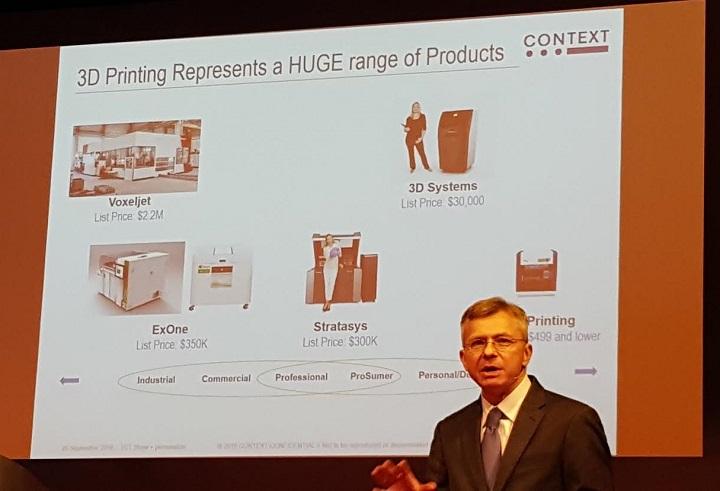CONTEXT: Desktop 3D Printer Market Continues to Grow While Industrial 3D Printers Are Down – But Not For Long
You’ve likely heard someone repeat the statement “One day, there will be a 3D printer in every home!” at some point. Whether that’s true or not remains to be seen, and some industry experts still express doubt that consumer 3D printing is the future of the industry. Numbers don’t lie, however, and according to the most recent report from IT market research company CONTEXT, desktop 3D printers are a hot commodity right now.
The 3D printer market overall is healthy and thriving, it would appear – according to CONTEXT, worldwide shipments of 3D printers rose by 25% in the first three quarters of 2016. 96% of those were personal desktop printers, with an average price falling below $1,000. The continuing trend towards lower-cost desktop 3D printers is certainly a factor in their growing popularity, as more consumers decide to make investments in their own personal machines.
Desktop printers saw a 27% year-on-year growth, while industrial/professional 3D printers dropped by 12%. Only 7,726 industrial 3D printers were shipped in the first three quarters of 2016, although they still accounted for 78% of global revenue due to their much higher cost.
So who were the biggest players in the desktop printer market? As it turns out, nothing much has changed there since 2015. In terms of units sold, four of the five top companies from CONTEXT’s 2015 year-end report remain at the forefront – only 3D Systems, which announced that they would be exiting the consumer printer market at the end of 2015, fell out of the top five, with ultra-low-cost retailer Monoprice moving into the number five spot.
Want to take a guess at who was number one? Yep, it was XYZprinting, once again. The Taiwanese manufacturer, which started the year out by announcing their plans to release seven new 3D printers in 2016, dominated the market with 46,300 units sold in the first three quarters of 2016, compared to a full-year total of 50,100 in 2015. Coming in second was Ultimaker, followed by M3D and Flashforge.
“While Stratasys and 3D Systems continued to shift away from the mainstream Personal/Desktop 3D Printer market, other brands – especially XYZprinting, filled the void,” said Chris Connery, VP for Global Analysis at CONTEXT. “Demand continues to be seen for these devices across the globe as evidenced by rising shipments, the emergence of new brands and large crowdsourced start-ups continuing to come on the scene.”
A few months ago, we heard Connery expand on the 3D printing market at TCT Show, where he emphasized his positive views on the future of desktop printers. We also chatted with him a few months earlier at IMTS, where the spotlight was on HP and their high-profile entrance into the 3D printer market. While HP didn’t begin shipping until the end of 2016, they still made plenty of impact on the industrial printer market; they were actually responsible for a slowdown in the market as customers held off on investing in industrial 3D printers until more is known about HP’s technology and its impact.
The industrial 3D printer market has slowed down overall in the past few years, but metal 3D printers remain on top. Even metal saw some drop in sales, though, with the market shaken up by GE’s acquisition of Arcam and Concept Laser in the second half of the year. In terms of revenue, Stratasys remained on top with a 35% share in industrial/professional 3D printer revenues, followed by EOS, 3D Systems, SLM Solutions and Concept Laser.
Projections for the full year 2016 will likely reflect the same trends as the first three quarters, while CONTEXT expects 2017 to see more growth for industrial/professional 3D printers as the HP and GE shakeups start to pay off. Meanwhile, the desktop/personal 3D printer market is expected to remain strong. Overall, the outlook is good for the 3D printing industry, says Connery.
“Beyond just printer shipments, the total 3D Printing market, consisting of Printers, Materials and Services, is projected to rise from under $5B in 2016 to $16B by 2020 mostly dependent on the industry’s ability to move beyond prototyping and into finished good production not just with metals but with plastics as well,” Connery explained.
Discuss in the CONTEXT forum at 3DPB.com.
Subscribe to Our Email Newsletter
Stay up-to-date on all the latest news from the 3D printing industry and receive information and offers from third party vendors.
You May Also Like
IperionX Inks 10-Year Deal with Wisconsin Manufacturer for 80 Metric Tons of Titanium Per Year
IperionX, the Charlotte-based supplier of sustainable titanium powders used for additive manufacturing (AM) and metal injection molding (MIM), has signed a ten-year deal with United Stars, a group of industrial...
Gastronology Launches Industrial Production of 3D Printed Food for Dysphagia Patients
Food 3D printing has, in many ways, been an additive manufacturing (AM) segment looking for the right business case. While some applications are beautiful and others may or may not...
Lockheed Martin Leads $3M Investment in Q5D’s Electronics 3D Printing System
Q5D, an original equipment manufacturer (OEM) of robotic arm, hybrid additive manufacturing (AM) systems used for wire harness production, has closed a $3 million investment round. The investment arm of...
3D Printing News Briefs, April 6, 2024: Depowdering, Cybertruck Door Handles, & More
In today’s 3D Printing News Briefs, ioTech’s digital manufacturing CLAD technology is opening up opportunities for microelectronics and additive manufacturing. Hexagon and Raytheon Technologies commercially released the Simufact Additive Process...




































